Contents
History Of Arc Welding
Arc welding is a process that has evolved since the early 1900s. From its humble beginnings as a welding technique that could barely accomplish rudimentary tasks to the highly sophisticated and reliable job it can do today, arc welding has proven itself to be one of the most valuable tools for welders in multiple industries.
While there were many advancements made before arc welding was developed, it was in 1922 when another significant leap forward was taken by inventors in introducing what would become known as electric arc welding.
It became an invaluable tool for steelworking applications. It meant greater productivity through higher speeds gained from more powerful arcs formed with more extended electrodes than open-air arcs could create.
Over the years, different types of electric arcs have improved welds’ strength and quality, allowing for more substantial structures, lighter materials, and faster completion times.
In this blog post, we’ll explore some critical milestones within Arc Welding history – diving into how electricity transformed metal work forever!

What Is Arc Welding?
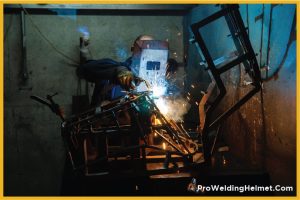
Arc welding is a type of welding that uses electricity to create an electric arc between two electrodes and the workpiece material, where intense heat is generated.
This heat energy melts the metal components and fuses them. Arc welding passes a direct current (DC) between an electrode and a base metal, creating an electrical arc that heats both materials enough to form a welded joint.
In this process, it’s essential to have good electrical contact between the electrode and the base material to transfer all the energy into the workpiece.
The Beginnings Of Arc Welding
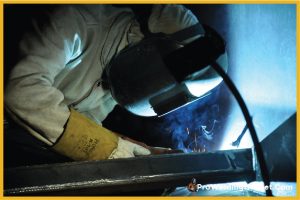
In its most rudimentary form, arc welding was developed in 1867 when Sir Humphry Davy fused two iron rods using an electric arc created between them. But it was in the 1920s that arc welding began to be developed as a practical technology.
In 1922, a patent was granted to J.B. Stoody for using an electric arc in welding and joining materials together, which eventually led to the development of shielded metal arc welding (SMAW).
This technique involved using direct current arcs to join metals with electrodes encapsulated in flux, shielding the weld area from airborne contaminants and preventing arc blowout.
Arc Welding Today
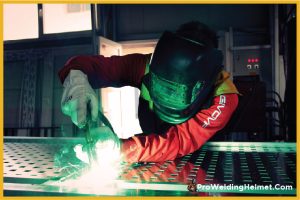
In modern times, there have been several advances in arc welding technology, such as gas tungsten arc welding (GTAW), which relies on a non-consumable tungsten electrode to generate the arc, providing greater accuracy and control over the welding process.
Other advances include gas metal arc welding (GMAW), which utilizes a consumable wire feed to provide filler material for the weld.
This technique is also often used with robots That can be programmed to repeat specific weld pattern sequences while using an inert gas as a shielding medium.
Arc welding has changed significantly since its inception in 1922 and continues to improve with each innovation. But one thing that remains consistent is its ability to join materials quickly and reliably, making it a valuable tool for many industries worldwide.
From aerospace engineering and automotive manufacturing to construction and fabrication – arc welding remains an integral part of the modern-day industry.
How Does Arc Welding Work?
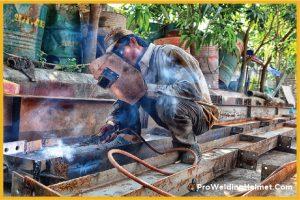
Arc welding uses an electric arc between a base metal and the electrode connected to the power source. As electricity passes through the two materials, it creates intense heat, melting both metals and joining them together.
The molten material is known as the weld puddle and will continue to grow as long as the current is supplied from the power source.
Variations in speed and fluidity of the puddle can be achieved with different techniques, such as pulse welding, which allows for better control over weld penetration, surface finish, and overall quality of the finished product.
What Are the Various Uses For Arc Welding?
Arc welding is used for various purposes, including fabrication, repair, and construction. It’s commonly used in automotive and aerospace manufacturing, shipbuilding, pipefitting, and other industrial applications.
Arc welding is also helpful in creating custom artwork as it can create intricate shapes and patterns out of metal, which is impossible with other types of welding. Whether you’re constructing a bridge or decorating your home, arc welding can turn your vision into reality!
Advantages of Arc Welding
- Good impact strength
- High deposition rates possible
- Welds can be made in almost any position
- Solid and reliable welds with superior quality
- High resistance to corrosion and fatigue
- Excellent aesthetic appeal due to minimal post-weld cleanup
Disadvantages of Arc Welding
- May suffer from porosity if not done properly
- Requires special safety equipment such as welding helmets, respirators, and shields
- Heat distortion can occur if the procedure is not followed correctly
- The presence of moisture or rust on the workpieces can lead to poor weld quality
Overall, arc welding remains one of the most versatile and widely used forms of metal joining available today – capable of producing solid and reliable welds on various materials with minimal preparation. With proper training and equipment, arc welding can be an invaluable tool for any job.
Types Of Arc Welding
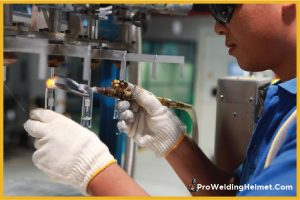
Arc welding is a versatile and commonly used method of joining metals, but many different types can be used depending on the project.
Shielded Metal Arc Welding (SMAW):
This process relies on an electrode with a flux coating to generate an arc between the base metal and the electrode to create a welded joint. The flux coating also protects from atmospheric contamination.
Gas Metal Arc Welding (GMAW)
Also known as MIG welding, this process utilizes electricity and a consumable wire feed to melt metal for welding. GMAW is generally easier to learn than SMAW and often requires less cleaning up after completing the job.
Submerged Arc Welding (SAW)
This type of welding utilizes an arc between a continuously fed electrode and the workpiece. It is shielded from atmospheric contamination by a blanket of granular flux, which also helps to increase weld speed and penetration.
Flux-Cored Arc Welding (FCAW)
Like MIG welding, this process employs a tubular wire feed filled with flux for increased arc stability and deeper penetration. This method is often used in shipbuilding, construction, pressure vessels, and other heavy industrial applications.
Gas Tungsten Arc Welding (GTAW)
Also known as TIG welding, this process uses a non-consumable tungsten electrode to create an arc between the workpiece and a filler rod. This method is well suited for making precise, high-quality welds with minimal distortion.
Whatever your welding needs, there’s an arc welding process that can meet them! With the proper technique and equipment, you’ll be able to join metals of all types together quickly and safely.
Conclusion
Arc welding is a powerful tool that allows you to make solid and reliable welds on various materials in almost any position.
It can be used for fabrication, repair work, construction, artwork, and more – so whether you’re working on a project at home or in an industrial setting, it can get the job done.
This versatile welding process can be invaluable for your business or hobby with the proper training and equipment.
By learning about the different types of arc welding available and understanding their advantages and disadvantages, you’ll be better able to decide which method is best suited for your project. So don’t wait any longer – get started with arc welding today!